
Of all the big-budget, highly-specced smartphones that appear throughout the year, the Oppo Find X3 Pro is not one that you’ll immediately be familiar with.
But like the Samsung Galaxy S21 Ultra and the iPhone 12 Pro Max before it, this is a powerful slab of pocket technology with a four-figure price tag to go with it.
Oppo isn’t a well-known name in the UK, but it recently became the biggest phone-maker in its native China after knocking beleaguered Huawei off the top spot. Like Huawei, it offers plenty of choice when it comes to the products. The Find X3 series, for example, comes in three flavours: Pro, Lite and Neo.
While the Neo and Lite (£699 and £379 respectively) are also launching in the UK – it’s the £1,099 Pro variant that I’ve been testing out for the last couple of weeks.
Oppo has outfitted the Find X3 Pro with a Qualcomm Snapdragon 888 processor, capable of speeds up to 2.84GHz and fully 5G ready for when the UK’s telecoms infrastructure catches up to China’s impressive rollout.

There’s 256GB of on-board storage, 12GB of LPDDR5 RAM and a 4,500mAh non-removable lithium ion that can be charged at 60W fast charging via USB-C or 30W through wireless charging with Oppo’s ‘AirVOOC’ system.
The battery life will see you through a full day, from 6am to around 11pm without any trouble. You will, however, have to power it up each night. If you’re going to buy a phone like this, chances are you’re going to be using it heavily. By that, I mean lots of photography work, media consumption and plenty of pairing with accessories and smart home devices. All of which take a toll.
But the aforementioned specs are pretty much what you’d expect for a flagship Android device costing over a grand.
So, what does the Oppo Find X3 Pro do differently?
Well, if you flip the phone over, you’ll see the camera bump has actually been housed inside the 193g chassis of the phone. It’s first of its kind to have this kind of camera tech nestled inside a unibody frame. Look at rival phones, and the camera bump is an appendage stuck onto one of the corners.
Oppo calls this design ‘cohesive’, ‘balanced’ and ‘futuristic’, and it certainly draws the eye. In real life, the bump (there is still a bump) isn’t as pronounced as it appears in the pictures. It looks like a small lump underneath a particularly velvety blanket.

The achievement is impressive but, in my opinion, it’s undone by the decision to go with a glossy, reflective finish. This means that, within thirty seconds of handling the phone it’s covered in smears and fingerprint smudges. There is a ‘Blue’ colour available as well which, from the pictures, seems like it may fare better in this regard.
Both colours are available from O2, Carphone Warehouse or Oppo directly while EE, Vodafone, Three, Virgin Mobile and Sky will only offer the Gloss Black option.
Next up: the display.
Oppo is talking up the screen on the Find X3 Pro as the first to offer support for a ‘true billion colour display’. This means the 3,216 x 1,440, 6.7-inch screen has the potential to display up to a billion colours compared with the mere 16.7 million found on other smartphones.
The way this was illustrated to me was that a typical picture of a sunset may show visible bands of colour as the brightness from the sun gives way to the dusky edges of the sky. By contrast a photo shot with, and viewed on, the Find X3 Pro’s screen is a smooth, seamless transition of colour from bright to dark.
Whether or not the average smartphone viewer will take this into account when staring at message bubbles, website articles or compressed and edited social media pictures is another matter. Colour grading aside, the screen has a 120Hz refresh rate, a 1,300 nit top brightness and HDR 10+ for viewing high dynamic range content. It is, all things considered, a lovely screen to behold if you’re using it for watching movies or playing games.

The final area of interest is the camera array. The Oppo Find X3 Pro features four camera lenses, consisting of wide-angle and super-wide-angle 50-megapixel main lenses (both using Sony IMX 766 sensors) alongside a 13-megapixel telephoto camera and a 3-megapixel microlens.
The 50-megapixel main cameras have a f1.8 aperture and use ‘intelligent pixel-combining’ to capture 12.5-megapixel images as standard.
For point-and-shoot users, the Find Pro X3’s range of modes and lenses will likely be unnecessary. But if you want to tweak and experiment, there’s plenty here to keep you occupied.

I’m a big fan of the photos produced by both the iPhone 12 and Google’s Pixel 5. But I wish both those phones gave you a few more settings to play with. On the Find X3 Pro, you can shift along to Pro mode within the camera app and start dabbling with ISO levels, the White Balance alongside the usual features like time-lapse and portrait.
The Find X3 Pro lets you shoot in RAW+ format, giving you HDR capture in the photographer’s RAW format. Switch to video, and you can shoot in 4K with support for the BT.2020 colour gamut that the aforementioned billion colour screen can draw out. There’s optical and electronic stabilisation, meaning you won’t need a gimbal if you’ve got relatively steady hands.
Finally, the microlens gives you up to 60x magnification for taking some – frankly ridiculous – macro shots. There’s a specific mode called ‘microscope’ that lets you see an object like a leaf or fabric in ridiculous detail. To illustrate, here’s a ‘microscope’ picture of my jeans:

Have a look at the picture below to get an idea of the Find X3 Pro’s camera performance in the real world.

When pitched against the Google Pixel 5 in a head-to-head shootout, the Oppo Find X3 Pro was able to pick out plenty of detail, but seemed to favour a cooler colour palette than Google’s Android flagship.
On the software side, Oppo skins Android with ColorOS11.2 which imposes minimal bloatware on top of all the Google apps you’d expect to find pre-installed. There’s one app called ‘Game Space’ that lets you tailor the device performance to your gaming habits – which seems a bit unnecessary when it comes to mobile games.
Another, called ‘relax’, plays soft white noise and offers a few simple games to, well, relax.
No modern smartphone rides alone any more. There needs to be an ‘ecosystem’ (buzzword of the moment) to support it. Apple and Samsung both offer phones, watches, earbuds, fitness apps and exclusive content to prop up their products. Oppo does too. If you’re so inclined, you can pair the Oppo Find X3 Pro with the Oppo Watch and Oppo Enco True Wireless Earbuds. Both of which look almost identical to the Apple Watch and AirPods.
The Oppo Find X3 Pro certainly meets the criteria for a flagship Android handset in 2021, and those looking for specs and performance won’t be disappointed.
I’m not sure the design will be to everyone’s tastes, but there are no qualms when it comes to performance. If you’re going to charge over a thousand pounds for a phone then it has to be up to the task.

The Oppo Find X3 Pro 5G strikes the balance between including the power and the features that people will use and disregarding a lot of the extras they won’t need.
In many ways, the fate that befell Huawei in China could be replicated here. As US sanctions continue to hobble excellent hardware like the Huawei Mate 40 Pro, it seems like Oppo could benefit. Android users who would normally hold out for the next Huawei device could well find themselves looking here instead.




